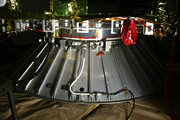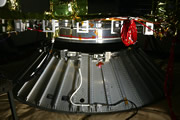Topics List
Feb. 18, 2020 Updated
Massive bushfires in Australia seen from Space
|
Australia has naturally faced many droughts and bushfires, but conditions have been unusually severe this time. Sometime around September 2019, the bushfires continuously occurred around the state of New South Wales in southeast Australia. The fires had been spreading on a larger scale, and a number of massive fires had merged into a "Mega Fire" that was out of control. The fires are unlikely to end entirely even at the end of January 2020. 
Figure 1 (left) Standardized Precipitation Index (SPI) in Australia calculated by GSMaP precipitation amount in a month (December 2019), (right)SPI calculated by GSMaP precipitation amount in three months (October-December 2019) in a same way. The relations between SPI value, the range of drought and frequency of phenomenon were classified by WMO (2012). In case SPI value becomes "-1.5 to -1.99", it indicates the situation of "Severe dryness" which happens "once in 20 years". In case SPI value becomes less than -2.0, it corresponds "Extreme dryness" which happens "once in 50 years". These condition shows the possibility of severe drought occurrence which leads to a big social impact. |
Oct. 27, 2016 Updated
Whole-atmospheric Monthly CO2 Concentration Tops 400 ppm based on IBUKI observation
|
The Ministry of Environment, National Institute of Environmental Studies and JAXA monitor CO2 level by JAXA's Greenhouse gases Observing SATellite IBUKI (GOSAT). The Provisional analysis was done of IBUKI's observational data obtained until May 2016. The results show that the global atmospheric monthly mean CO2 concentration observed vertically through the whole atmosphere exceeded 400 ppm for the first time in February 2016. In addition, the monthly CO2 concentration, after hitting the 400 ppm mark in December 2015, reached the unprecedented level of 402.3 ppm in December 2015. It is the highest record since GOSAT was launched in 2009. |
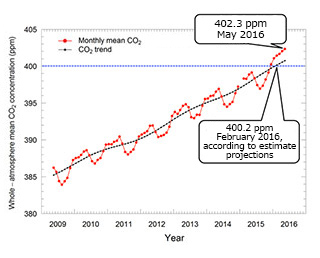
|
|---|
May 20, 2016 Updated
Whole-atmospheric monthly CO2 concentration tops 400 ppm based on observations by IBUKI
|
A recent provisional analysis of IBUKI (GOSAT) observational data shows that the global atmospheric monthly mean CO2 concentration observed vertically through the whole atmosphere exceeded 400 ppm in December 2015 for the first time since GOSAT was launched in 2009.
|
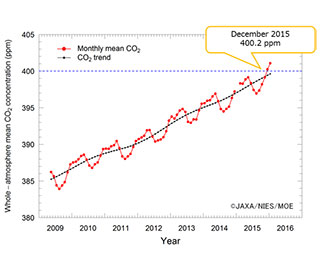
|
|---|
Nov. 27, 2015 Updated
IBUKI methane observation data: close correlation between methane concentration and human activity
|
As a result of analyzing three-year observation data acquired by the Greenhouse Gas Observing Satellite “IBUKI” (GOSAT) until Dec. 2012, the concentration of methane is higher in areas where anthropogenically-derived methane emission is intense, such as densely populated areas, large-scale agricultural regions, natural gas and oil producing/refining areas, compared to other surround areas. |
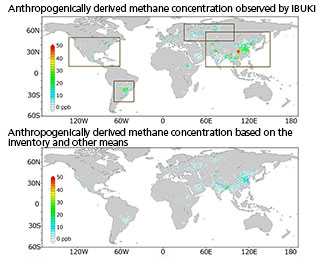
|
|---|
Nov. 16, 2015 Updated
Public release of whole-atmosphere monthly mean CO2 concentration based on observations by IBUKI
|
"IBUKI" (GOSAT) has been in operation since its launch on January 23, 2009. The whole-atmosphere monthly mean concentration of carbon dioxide (CO2), calculated by using GOSAT data that reflect CO2 levels in all layers of the atmosphere, was found to have reached 398.8 ppm in May 2015, while showing seasonal oscillation and yearly rise over the analyzed period. It was also confirmed that the trend line of the whole-atmosphere CO2 mean (average seasonal cycle removed) had reached 398.2 ppm in July 2015. The trend line is expected to exceed 400 ppm within the year 2016, given that the rising trend continues. The GOSAT observation elucidates for the first time that CO2 concentration averaged over all layers of the atmosphere will soon reach the level of 400 ppm, and demonstrates the importance of global greenhouse gas monitoring from space. |
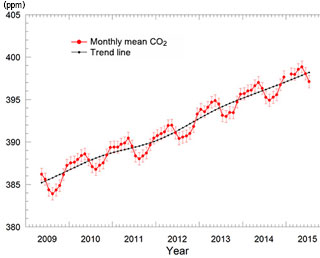
|
|---|
Dec. 25, 2014 Updated
"IBUKI" (GOSAT) Satellite's Historically Unprecedented Observation of Anthropogenic CO2 Emissions of Mega-City Regions from Space
|
The Greenhouse gases Observing SATellite "IBUKI", developed jointly by the Ministry of the Environment (MOE), the National Institute for Environmental Studies (NIES), and the Japan Aerospace Exploration Agency (JAXA) is the world's only satellite designed specifically to monitor greenhouse gases from space. The satellite has continued to fulfill its main mission in monitoring atmospheric carbon dioxide (CO2) and methane concentrations from space to improve the accuracy of sink/source estimates, and achieve its target to contribute to precision refinement for the ongoing elucidation of carbon cycles, since its launch on January 23, 2009. |
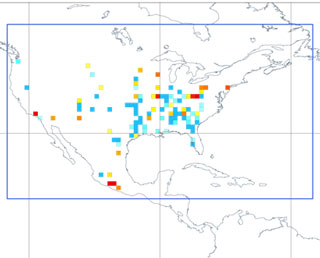
|
|---|
Dec. 6, 2012 Updated
Public release of carbon dioxide flux estimates based on observation data by IBUKI
|
The data of global CO2 fluxes on a monthly and regional basis for the one-year period between June 2009 and May 2010 has been publicly distributed for the first time in the world. These flux values were estimated by combining ground-based CO2 monitoring data and CO2 concentration data acquired through the improved observation method of the Greenhouse gases Observing SATellite "IBUKI." (GOSAT). The calculation method has been improved for the concentration of greenhouse gases. The usefulness of the concentration data acquired by the satellite was quantitatively verified. |
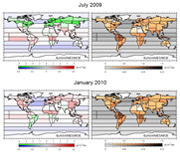
|
|---|
Oct. 28, 2011 Updated
IBUKI observations help reduce estimation error of the CO2 absorption and emission
|
The Ministry of the Environment, the National Institute for Environmental Studies, and JAXA calculated the error or uncertainty of the estimation results for monthly global and regional CO2 absorptions and emissions using data acquired by the Greenhouse Gases Observing Satellite "IBUKI." As a result, we can reduce the error of the estimated values when we introduce IBUKI's observation data compared to that of the values calculated in a conventional way based on ground observation data. |
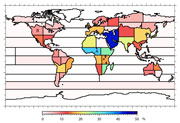 |
|---|
Aug. 20, 2010 Updated
Third Research Announcement on the "IBUKI" (GOSAT)
|
JAXA, the National Institute for Environmental Studies, and the Ministry of the Environment would like to make the third Research Announcement (RA) prior to the publication of the data acquired by the IBUKI (GOSAT) to the general public. The RA aims at evaluating the quality of data including calibration and validation data, and promoting usage and study of data.
|
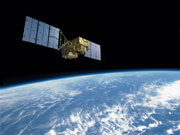 |
|---|
Apr. 28, 2010 Updated
IBUKI provides images of Iceland volcano eruption to the British Government
|
The Greenhouse Gases Observing Satellite "IBUKI" shoots all-globe images every three days using its onboard supplement sensor "Cloud and Aerosol Imager, TANSO-CAI." Since April 15, it took images of the fumes billowing over Iceland and other European countries, and of a major eruption on the 17th. |
 |
|---|
Feb. 16, 2010 Updated
IBUKI to provide analysis results of observation data (CO2 and methane concentration)
|
JAXA completed the initial validation of the concentration of carbon dioxide (CO2) and methane based on the analysis results of observation data in the clear region taken by the Greenhouse Gases Observing Satellite "IBUKI." Accordingly, we would like to begin to provide the above results as well as information on cloud covering to the general public on February 18, 2010. |
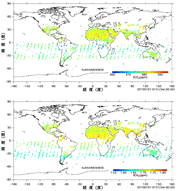 |
|---|
Nov. 11, 2009 Updated
Technical Interface Meeting over IBUKI observation data
|
Between November 10 (Tue.) and 13 (Fri.), a GOSAT-ACOS* technical interface meeting is being held at the JAXA Tsukuba Space Center and at the National Institute for Environmental Studies. In the meeting, we are discussing the calibration and verification of observation data acquired by the IBUKI to improve data accuracy so as to be ready for the distribution of density data to the general public that is scheduled to start in January 2010. |
 |
|---|
Oct. 30, 2009 Updated
Public Release of Observation Data (Radiance Spectrum and Images) from "IBUKI"
|
The Level 1 data products, which are radiance spectra observed by TANSO-FTS and images by the TANSO-CAI onboard the Greenhouse gasses Observing SATellite "IBUKI", will begin to be released to general users following the completion of the initial calibration. |
 |
|---|
Oct. 20, 2009 Updated
IBUKI Project won the Nikkei Global Environmental Technology Award
|
The “IBUKI” (GOSAT) project team received the “19th Nikkei Global Environmental Technology Award” (sponsored by Nikkei Inc., the publisher of Japan’s leading financial newspaper) after its satellite development and launch activities won praise. The award is granted to supreme achievements that contribute to “global environmental conservation and sustainable development” through investigation and research on environmental problems and/or development of technologies for such measures. |
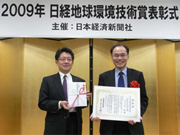 |
|---|
Jul. 22, 2009 Updated
IBUKI took images of total solar eclipse
|
A total solar eclipse was observed from Japan on July 22 for the first time in 46 years. The Greenhouse Gases Observing Satellite "IBUKI" took some images of a shadow of the moon on the earth. |
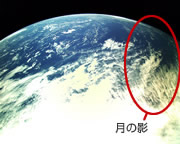 |
|---|
May 28, 2009 Updated
IBUKI analyzed greenhouse gas density for first time
|
JAXA, the National Institute for Environmental Studies, and the Ministry of the Environment acquired analysis results of the density of CO2 and methane in the fine weather areas on the ground for the first time from the Greenhouse Gases Observing Satellite "IBUKI," which is currently under initial calibration and verification operations. As a result of the analysis, we found that the density data was mostly consistent with the conventional data observed on the ground: the density is high in the Northern Hemisphere and low in the Southern Hemisphere. We will further calibrate and verify the data, and publish and distribute the observation data and analyses when they are ready. (Image: JAXA/NIES/MOE) |
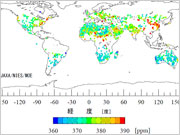 |
|---|
Apr. 22, 2009 Updated
IBUKI moves to the initial calibration and verification operation
|
The Greenhouse Gases Observing Satellite “IBUKI” has been under the initial functional verification mode to check the normal operation of onboard mission equipment, the satellite itself, and the ground system. On April 10, we moved to the initial calibration and verification operation phase. During this phase, all mission equipment will be calibrated and verified. |
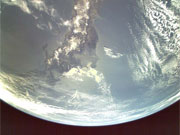 |
|---|
Apr. 7, 2009 Updated
Second Research Announcement on the "IBUKI" (GOSAT)
|
JAXA, the National Institute for Environmental Studies, and the Ministry of the Environment would like to make the second Research Announcement (RA) prior to the publication of the data acquired by the IBUKI (GOSAT) to the general public. The RA aims at evaluating the quality of data including calibration and validation data, and promoting usage and study of data. The RA is for the following five same areas as the first RA: |
 |
|---|
Mar. 19, 2009 Updated
Greenhouse Gases Observing Satellite "IBUKI" (GOSAT) " First Thermal infrared spectra" Acquired by Onboard Sensors
|
The Japan Aerospace Exploration Agency (JAXA) would like to announce that we successfully acquired the "First Thermal Infrared (TIR) spectra" by the Greenhouse Gases Observing Satellite "IBUKI" (GOSAT) during the course of its initial functional check. The data was acquired by the onboard sensors of the IBUKI, the Thermal And Near infrared Sensor for carbon Observation-Fourier Transform Spectrometer (TANSO-FTS) after the functional check of detector cooler. which had been completed recently. |
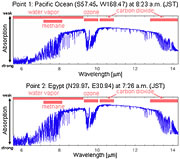 |
|---|
Feb. 9, 2009 Updated
IBUKI "First Light" Acquisition
|
JAXA successfully acquired the “First Light” by the Greenhouse Gases Observing Satellite “IBUKI” (GOSAT) during the course of its initial functional check. The data was acquired by the onboard sensors of the IBUKI, the Fourier Transform Spectrometer (TANSO-FTS) and the Cloud and Aerosol Imager (TANSO-CAI), which were just activated. The IBUKI was launched at 12:54 p.m. on January 23 (Japan Standard Time.) Its initial functional check has been carried out on schedule, and the satellite is in good condition. |
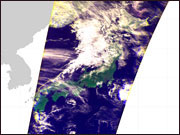 |
|---|
Jan. 24, 2009 Updated
"IBUKI" End of Critical Phase Operation
|
The Japan Aerospace Exploration Agency confirmed that the Greenhouse Gases Observing Satellite "IBUKI" (GOSAT) is now ready for the initial functional verification operation after shifting its attitude control system to the regular mode. Therefore, the critical phase operation of the IBUKI was completed at 5:15 p.m. on January 24, 2009 (Japan Standard Time, JST.) |
 |
|---|
Jan. 23, 2009 Updated
"IBUKI" successfully launched!
|
The Greenhouse Gases Observing Satellite "IBUKI" (GOSAT) was launched by the H-IIA Launch Vehicle No. 15 (H-IIA F15) at 12:54:00 p.m. on January, 23, 2009 (Japan Standard Time, JST) from the Tanegashima Space Center. |
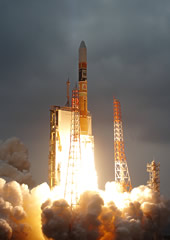 |
|---|
Jan. 7, 2009 Updated
IBUKI encapsulated in payload fairing
|
|
 |
|---|
Dec. 9, 2008 Updated
IBUKI open to the press at TNSC
|
On December 9, the Greenhouse Gases Observing Satellite "IBUKI" was revealed to the press at the Spacecraft Test and Assembly Building #2 (STA2) at the Tanegasima Space Center (TNSC.) The IBUKI is now in its final preparation phase. |
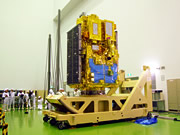 |
|---|
Nov. 5, 2008 Updated
Launch day of "IBUKI" set! Launch Special Site open
|
The launch day and lift-off time of the H-IIA Launch Vehicle No. 15 (H-IIA F15) was announced to be between 12:54 and 1:16 p.m. on January 21, 2009. The main payload of the H-IIA F15 is the Greenhouse Gases Observing Satellite "IBUKI" (GOSAT.) |
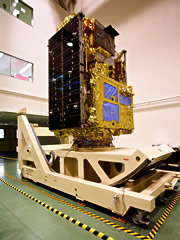 |
|---|
Oct. 15, 2008 Updated
'IBUKI' Chosen as Nickname of the GOSAT
|
"IBUKI" was selected as the nickname of the Greenhouse Gases Observing Satellite (GOSAT), which is scheduled to be launched this Japan fiscal year, after 12,683 applications were received from the general public. |
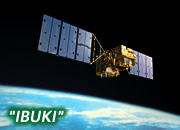 |
|---|
Oct. 9, 2008 Updated
Solar Array Paddle Deployment Shock Test
|
On August 26, 2008, the GOSAT project team performed the solar array paddle deployment shock test. The paddles are essential for the satellite to generate the necessary power for its onboard equipment. They are stowed at the time of launch to be released by firing pyrotechnics when the satellite is injected into its initial orbit. |
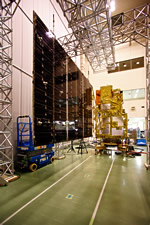 |
|---|
Oct. 2, 2008 Updated
GOSAT: Pyro-shock Test of the Proto-flight Model
|
Launch preparations for the GOSAT are smoothly underway targeting a launch within this fiscal year.
|
Aug. 19, 2008 Updated
PFM vibration test going smoothly
|
The GOSAT is currently undergoing a proto-flight model (PFM) vibration test. |
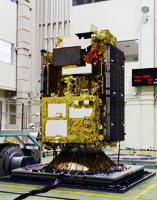 |
|---|
Jul. 10, 2008 Updated
Want to be a godparent of a satellite?
Seeking a nickname for the Greenhouse Gases Observing Satellite (GOSAT)
|
The "GOSAT" is the first satellite to observe greenhouse gas around the Earth from space in order to further promote measures to deal with global warming. |
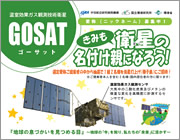 |
|---|
Apr. 16, 2008 Updated
Thermal Vacuum Test on Greenhouse Gas Observation Sensor and General Test using the Proto Flight Model were performed
|
On January 28, 2008, the Thermal Vacuum Test on the Greenhouse Gases Observing Satellite "GOSAT" was performed at the Tsukuba Space Center. (Top Photo) During the Thermal Vacuum Test, the Greenhouse Gas Observation Sensor that will aboard the satellite is placed in the chamber simulating the space environment in order to test if it works properly or not. On March 1, 2008, a General Test was also performed using the Proto Flight Model. (Bottom Photo) During this General Test, the wires and antennas were assembled. |
 |
|---|
Jan. 30, 2007 Updated
GOSAT STM open to the press
|
The structural thermal model (STM) of the Greenhouse Gases Observing Satellite "GOSAT" was open to the press on January 29 at the Tsukuba Space Center. |
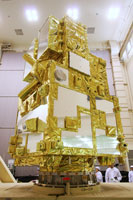 |
|---|
May 31, 2006 Updated
The third GOSAT symposium
|
On May 29, the third Greenhouse Gases Observing Satellite (GOSAT) symposium was held at Akihabara Convention Hall (Tokyo.) Following the project status report, lectures were given on the collaboration between the NASA OCO plan and the CO2 observation project of the GOSAT, as well as the latest research results on climatic change, and the role of electric cars for solving the global warming trend. Some 300 participants enthusiastically listened to the speakers. At the symposium, the project team felt people's expectations for the GOSAT firsthand. |
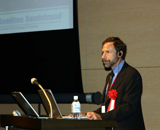 |
|---|
Apr. 22, 2004 Updated
Symposium on the Utilization of GOSAT
|
On April 21, a symposium was held in Tokyo by organizations that are in charge of the development and operation of the GOSAT. They are the Ministry of Environment, the National Institute for Environmental Studies, and JAXA. After guest speakers Prof. Berrien Moor III of the University of New Hampshire and Prof. Yoshifumi Yasuoka of the University of Tokyo talked, a panel discussion was held by domestic and international academics on global warming issues, the necessity of CO2 observations, and the status of the GOSAT project. For more details, please check the site for the Symposium on the Utilization of Greenhouse Gases Observing Satellite (GOSAT). |
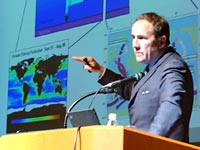 |
|---|
